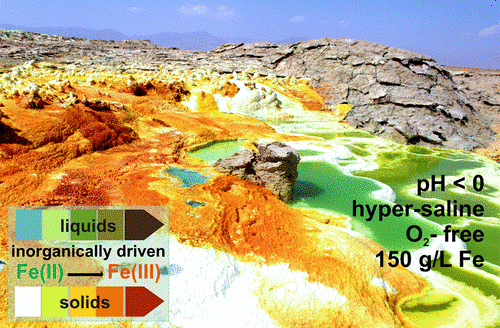Kotopoulou, E., Delgado Huertas, A., Garcia-Ruiz, J. M., Dominguez-Vera, J. M., Lopez-Garcia, J. M., Guerra-Tschuschke, I., & Rull, F. (2018). A Polyextreme hydrothermal system controlled by iron: the case of Dallol at the Afar triangle. ACS Earth and Space Chemistry, 3(1), 90-99.
Download here: https://pubs.acs.org/doi/pdf/10.1021/acsearthspacechem.8b00141
One of the latest volcanic features of the Erta Ale range at the Afar Triangle (NE Ethiopia) has created a polyextreme hydrothermal system located at the Danakil depression on top of a protovolcano known as the dome of Dallol. The interaction of the underlying basaltic magma with the evaporitic salts of the Danakil depression has generated a unique, high-temperature (108 °C), hypersaline (NaCl supersaturated), hyperacidic (pH values from 0.1 to −1.7), oxygen-free hydrothermal site containing up to 150 g/L of iron. We find that the colorful brine pools and mineral patterns of Dallol derive from the slow oxygen diffusion and progressive oxidation of the dissolved ferrous iron, the iron-chlorine/-sulfate complexation, and the evaporation. These inorganic processes induce the precipitation of nanoscale jarosite-group minerals and iron(III)-oxyhydroxides over a vast deposition of halite displaying complex architectures. Our results suggest that life, if present under such conditions, does not play a dominant role in the geochemical cycling and mineral precipitation at Dallol as opposed to other hydrothermal sites. Dallol, a hydrothermal system controlled by iron, is a present-day laboratory for studying the precipitation and progressive oxidation of iron minerals, relevant for geochemical processes occurring at early Earth and Martian environments.


